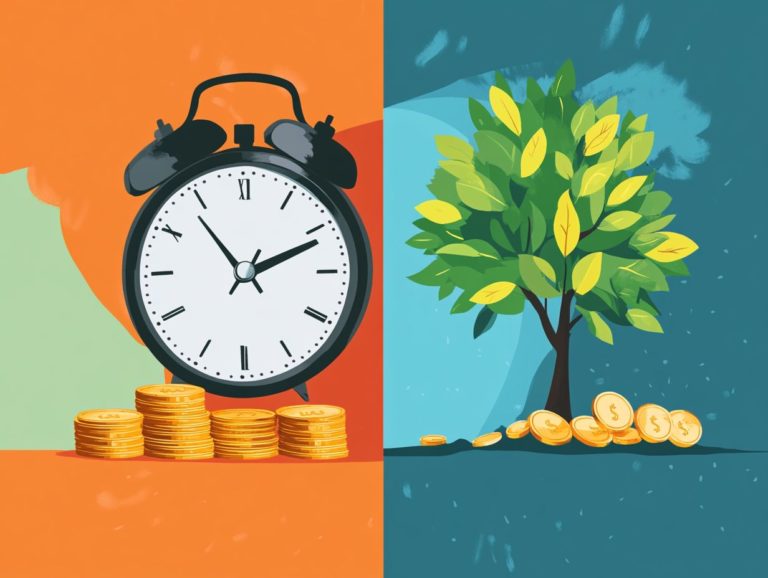How to Build Passive Income as a Freelancer
Passive income refers to earnings received on a regular basis with minimal effort required to maintain it. While often confused with terms like unearned income or investment income, it is important to understand that these terms are not interchangeable. In the world of freelancing, many seek to understand this distinction to enhance their financial strategies.
In the financial context, passive income encompasses earnings derived from sources such as rental properties, limited partnerships, or other ventures in which an individual is not actively involved. This stands in contrast to active income, which is earned through direct participation in a business, trade, or profession, including salaries, wages, commissions, and tips. Freelancers often rely on this understanding to create diverse income streams.
Some common forms of passive income include strategies that freelancers can implement:
- Rental income
- Dividends from stocks
- Interest from bonds
- Peer-to-peer lending
Other examples include royalties from creative works, affiliate marketing, guest blogging, or any business that requires little to no ongoing effort to sustain.
Contents
- Key Takeaways:
- Understanding Passive Income in Freelancing
- Benefits of Building Passive Income as a Freelancer in 2024
- Unlock Your Earnings: Smart Strategies for Passive Income in 2024
- Common Mistakes to Avoid when Building Passive Income
- Tips for Managing Passive Income as a Freelancer in 2024
- Long-Term Planning for Sustainable Passive Income
- Your Questions About Passive Income Answered
- What is passive income and why is it important for freelancers?
- How can freelancers build passive income?
- Is it possible to build passive income as a freelancer without a large investment?
- How can I leverage my skills as a freelancer to build passive income?
- What are some common mistakes freelancers make when trying to build passive income?
- Is it possible to achieve a full-time income through passive income as a freelancer?
Key Takeaways:
- Understand what passive income is and the different types available, including blogging and digital products.
- Building passive income as a freelancer can provide financial stability and flexibility while minimizing reliance on client work.
- Diversify income streams and leverage skills and expertise, such as teaching skills or consulting services, to generate passive income.
Understanding Passive Income in Freelancing
Passive income refers to earnings that freelancers receive from activities in which they are not engaged on a daily basis, in contrast to traditional active income derived from client work. This concept can lead to greater income satisfaction.
Freelancers can generate passive income through various avenues. For instance, they can create blogs or digital products, such as eBooks and online courses.
- Blogging
- Selling digital products like eBooks through platforms like Amazon or Etsy.
- Offering online courses on websites like Udemy or Futurelearn.
- Participating in affiliate marketing programs to earn commissions by promoting products they recommend.
Understanding passive income enables freelancers to diversify their income sources, strengthen their financial safety net, and enhance their overall satisfaction with income while effectively managing website maintenance and related tasks.
Definition and Types of Passive Income for Freelancers
Passive income refers to earnings generated from projects in which individuals are not actively involved. It offers a more flexible lifestyle and is particularly appealing to freelancers seeking to enhance and diversify their income streams. This approach allows them the freedom to pursue other creative endeavors or additional projects, such as teaching skills or offering consulting services.
By investing time upfront, individuals can establish income streams that continue to generate revenue without constant oversight, particularly through platforms like Shopify, Patreon, or Printful. As economic uncertainty grows, passive income is becoming an increasingly attractive financial strategy.
Various types of passive income can be categorized into several groups:
- Blogging
- Digital products, such as eBooks and online courses.
- Real estate investments that can provide rental income.
- Affiliate marketing through various online platforms.
For instance, freelancers can create a blog centered on their area of expertise, which may generate revenue through advertisements or sponsored content opportunities, including selling ad space. They can also develop digital products, such as eBooks or online courses, that continue to sell long after the initial work is completed. Platforms like Etsy can be utilized for printables, while Teachable can be used for courses.
By incorporating passive income strategies into their businesses, freelancers can cultivate a steady income stream that enhances their financial stability without the need for daily involvement.
Start exploring these passive income strategies today and take control of your financial future!
Benefits of Building Passive Income as a Freelancer in 2024
Passive income offers freelancers many advantages. It helps them manage the unpredictable nature of client work. Key benefits include reduced reliance on project work, increased earnings, diversification of income sources, and improved opportunities for personal growth, especially through teaching skills and consulting.
By generating passive income, freelancers can lessen their dependence on project-based work. This freedom allows them to pursue projects that ignite their passion. Many freelancers often feel overwhelmed by the continual hunt for new clients, making passive income a valuable solution for those seeking greater financial stability.
This reduced reliance on project work grants freelancers the flexibility to choose assignments that align closely with their skills and interests. It also opens the door to exploring niche markets.
Diversifying income streams helps protect freelancers from the uncertainties of relying on a single source of income. For example, if a freelancer faces a downturn in project work, their passive income can help bridge the financial gap until they secure new clients, enhancing overall income satisfaction.
With financial security, freelancers can excitedly invest time in their personal growth and development. They can take classes, enroll in online courses, or develop new skills to position themselves for their desired jobs in the future.
Achieving Financial Stability and Flexibility through Passive Income
Freelancers can enjoy significant financial stability and flexibility by pursuing passive income streams like promoting products from other companies or selling digital products. Establishing a steady income source that requires minimal active work alleviates financial anxiety and allows freelancers to make more intentional choices regarding the projects they undertake.
This financial cushion enables them to pursue opportunities that closely align with their interests and goals, such as creating online courses or blogging, rather than feeling compelled to accept projects that do not ignite their passion.
For instance, creating online courses lets freelancers monetize their expertise while generating passive income as students enroll over time, especially on platforms like Udemy or Lynda. Similarly, promoting products can earn freelancers commissions, such as from Gym Shark or Printful, with minimal active management required.
Unlock Your Earnings: Smart Strategies for Passive Income in 2024
Freelancers can generate passive income by employing various strategies to establish multiple income streams. This promotes financial diversification and sustainable growth across various markets.
Diversifying Income Streams for Long-Term Success
Diversifying income streams is a crucial strategy for freelancers looking to establish a strong passive income portfolio. Incorporating various methods for generating income, such as promoting products and selling digital products, helps mitigate risks and enhance financial stability.
For example, promoting products allows freelancers to earn commissions by sharing items they believe in, creating a unique combination of work and profit. Developing digital products, such as e-books or online courses, enables freelancers to leverage their expertise while earning money on autopilot, particularly through platforms like Shopify or Etsy.
Exploring other avenues, such as investing in real estate, stocks, or even maintaining websites, can further bolster financial security. This approach ensures that a downturn in one area does not significantly affect overall income.
Don’t wait – start your journey to financial freedom today!
Using Skills and Expertise for Passive Income
Freelancers can create passive income by using their skills to offer services like teaching and consulting. One great option is to develop online courses. This allows you to share your knowledge in a structured way. After the initial effort, you can continue earning with minimal extra work.
Writing eBooks is another path. This lets freelancers and companies share their expertise in detail. eBooks can cover topics that might be too long for videos, reaching an audience that prefers reading. You can sell them on platforms like Amazon.
Offering consulting services allows business professionals to provide one-on-one assistance based on their expertise. This often enables freelancers to charge higher fees for their specialized knowledge, further enhancing their income streams.
All of these options help freelancers establish themselves as experts in their fields. They also provide opportunities to earn income outside of traditional project work, paving the way for a more sustainable income model.
Common Mistakes to Avoid when Building Passive Income
Freelancers often make mistakes when building passive income. A common error is not diversifying income streams.
Pitfalls to Watch Out For in Freelancing
One major mistake is launching a digital product like an online course without testing the market first. Surveys or beta groups can help gauge interest and avoid a lack of demand.
Another issue is ineffective marketing. Many freelancers think social media alone will drive sales. This often isn’t enough, leading to disappointment and self-doubt.
After launching their product, many freelancers neglect to gather user feedback. Making necessary adjustments and prioritizing user engagement are crucial for maintaining income streams.
Tips for Managing Passive Income as a Freelancer in 2024
Effective management of passive income enables freelancers to maximize their earnings while maintaining a healthy work-life balance, essential for long-term success.
Organization and Time Management for Freelancers
Effective organization and time management are essential for freelancers aiming to balance their active client work with passive income projects. By implementing specific strategies, they can optimize their workflows and enhance productivity.
One effective approach is to utilize project management tools like Trello or Asana. These tools help prioritize tasks and visually track deadlines. Another helpful method is the Pomodoro Technique, a method that involves working in short bursts followed by breaks.
Establishing regular time blocks in their schedule for both client work and side projects can prevent overlap and maintain momentum. Furthermore, setting daily and weekly goals provides freelancers with the structure they need to stay motivated, ensuring that their passive income projects receive the attention they deserve.
Long-Term Planning for Sustainable Passive Income
Long-term planning is essential for freelancers seeking to build sustainable passive income that offers enduring financial benefits and opportunities for growth.
Investing and Reinvesting Earnings
Investing and reinvesting earnings are essential strategies for freelancers looking to enhance their ability to earn money without working constantly and create new opportunities for growth.
By thoughtfully evaluating options such as stocks and mutual funds, or developing new digital products, freelancers can establish a strong financial foundation while minimizing risks.
A well-planned strategy maximizes returns and allows for spreading your money across different investments, providing protection against market volatility.
Automated investment platforms simplify this approach and make regular contributions over time more manageable. A solid investment strategy enables freelancers to transform their hard-earned revenue into lasting assets, ultimately contributing to their financial security.
Your Questions About Passive Income Answered
What is passive income and why is it important for freelancers?
Passive income refers to earnings generated without actively working. Freelancers need passive income to enjoy financial stability and freedom.
How can freelancers build passive income?
Freelancers can build passive income by creating digital products, investing in dividend-paying stocks, renting out property, and developing online courses or membership programs.
Is it possible to build passive income as a freelancer without a large investment?
Yes, freelancers can start building passive income with minimal investment by creating digital products or services like e-books, templates, or online courses.
How can I leverage my skills as a freelancer to build passive income?
Freelancers can leverage their skills by creating products related to their niche. For example, a graphic designer can sell design templates, while a writer can offer e-books or online writing courses.
What are some common mistakes freelancers make when trying to build passive income?
Common mistakes include not diversifying income streams, failing to invest in their own skills, and neglecting consistent promotion of their products or services.
Is it possible to achieve a full-time income through passive income as a freelancer?
Yes, it is possible to achieve a full-time income through passive income as a freelancer. However, it requires time, effort, and dedication to build multiple streams of income.
Don’t wait—take the first step towards financial freedom today!










